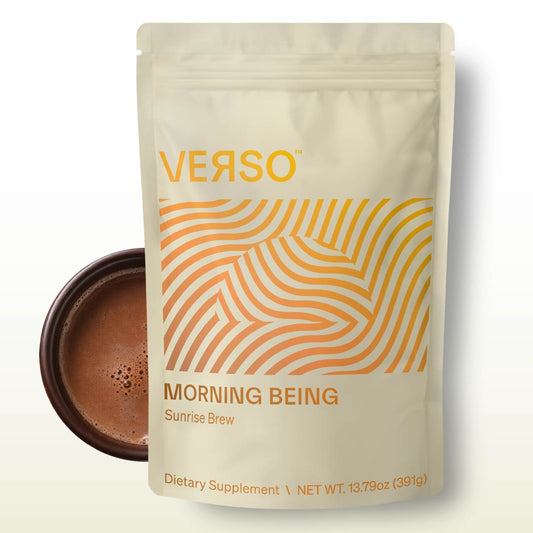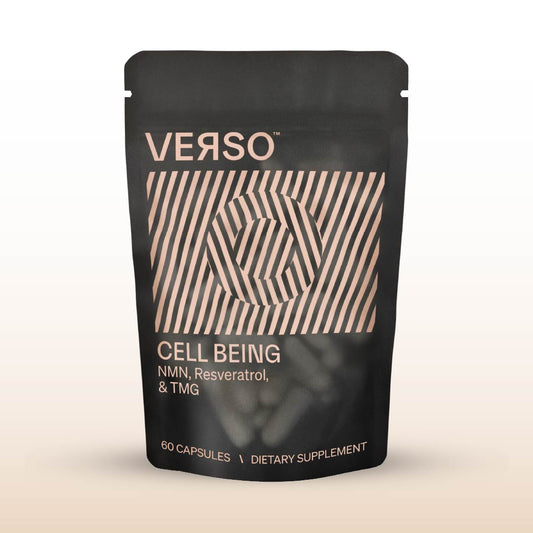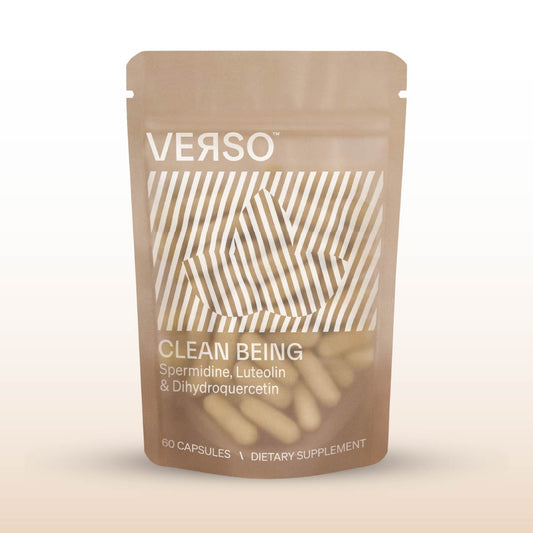There are many mechanisms involved in spermidine’s beneficial health effects. The most researched and major mechanism is spermidine’s ability to induce autophagy.
Spermidine is a compound found in living cells and in foods including soybeans, wheat germ, nuts, fruits such as grapefruit and also in vegetables like broccoli. It is a polyamine, meaning that it is an organic compound with two or more amino groups. Human concentrations of spermidine decline with age and can change depending on nutrition, synthesis of polyamines within the gut microbiome, and disease state. Spermidine plays a crucial role in the survival and function of cells, including supporting cellular growth, DNA health, and apoptosis(33). Increased levels of spermidine have shown to have protective effects for the following: lifespan, cancer, metabolic conditions, cardiovascular conditions and cognitive conditions (24). Spermidine also counteracts 5-6 hallmarks of aging, including epigenetic alterations, impaired proteostasis, mitochondrial dysfunction, stem cell dysfunction, and impaired and intercellular communication(22, 38). The mechanisms for spermidine’s beneficial effects are explored below.
WHAT ARE THE MECHANISMS OF SPERMIDINE?
There are many mechanisms involved in spermidine’s beneficial health effects.
SPERMIDINE INDUCES AUTOPHAGY
The most researched and major mechanism is spermidine’s ability to induce autophagy. It has been shown that spermidine administration induces autophagy, or cellular cleanout, in yeast, mice, flies and worms as well as cell cultures(6, 12, 34, 39). Much of spermidine supplementation’s cardioprotective, anti-cancer, neuroprotective and lifespan-extending effects stem from induction of autophagy, which declines with age(18). Meaning that these health benefits are dependent on autophagy. When autophagy is inhibited, spermidine no longer extends lifespan across organism/animal models (6, 14, 15, 58). In autophagy deficient mice, spermidine does not confer cardioprotective benefits(4, 31). Spermidines’ anticancer properties are also enabled by autophagy. Much of these same effects are also due to an increase in mitophagy, or cleanout of dysfunctional mitochondria, which supports overall mitochondrial health(8, 9, 12, 44).
SPERMIDINE STIMULATES THE DEACETYLATION OF PROTEINS
Induction of autophagy is stimulated by deacetylation of proteins, or removal of acetyl groups from proteins. Spermidine’s ability to induce autophagy is likely enabled by its ability to inhibit E1A-associated protein p300(EP300)(6, 34), which inhibits acetylation of proteins(20, 48) and could be related to acetylCoA levels which when low induce autophagy(7). Spermidine is more active in low acetylCoA environments(39). Spermidine also activates AMPK and inhibits mTORC1 which could also play a role in autophagy and spermidine’s health benefits(27, 39). The exact mechanisms for how spermidine stimulates autophagy need further elucidation.
SPERMIDINES IMPACT ON LONGEVITY-RELATED COMPOUNDS
It is theorized that long-term autophagy effects of spermidine also involve the longevity gene FoxO3(4, 26). In terms of heart health, there is some evidence that spermidine also increases vasodilator nitric oxide(NO), beneficially impacts arginine levels and derails oxidative damage, conferring cardioprotective benefits(8, 18). Spermidine also might be involved in the phosphorylation proteins that would otherwise be damaging.
SPERMIDINE REDUCES INFLAMMATION AND STIMULATES THE IMMUNE SYSTEM
Another mechanism of action is spermidines ability to reduce inflammation and stimulate the immune system, this is of particular interest for spermidines anticancer properties. Autophagy enables the immune system to recognize cancer cells, which leads to improved immunosurveillance(19, 23, 30, 40). Additionally, spermidine is able to improve memory T cell function and response(dependent on autophagy)(42, 43). Spermidine is able to reduce inflammation by preventing the secretion of cytokines which lead to inflammation, in part due to autophagy(8, 17). Expression of lymphocyte function-associated antigen-1(LFA-1)(necessary for immune cell migration) increases with age(52). LFA-1 is suppressed by spermidine supplementation in aged mice(16, 51). This might be of significance due to LFA-1’s potential proaging relationship with DNA methylation of pro-inflammatory factors(16, 51, 57).
Spermidine also modulates facets of brain function. Neuroprotective effects of spermidine are mostly attributed to autophagy and anti-inflammatory effects, but still need further exploration. Spermidine supports proteostasis, protein regulation, in areas of high synaptic activity, which depends on autophagy and is important for neural function(25). Another theory for how spermidine exerts neuroprotective effects is that it acts on inflammation and immune cells, preventing cerebral tissue invasion(13, 57). To better understand these mechanisms, it is critical to understand whether or not spermidine is able to cross the blood-brain barrier in humans, which is widely unknown(5, 49).
WHAT DOES THIS ALL MEAN?
As the aging population grows, rising rates of chronic illness need to be addressed. There are several ways to mediate these rising rates, including lifestyle factors, like diet and exercise, and pharmacological interventions. Currently in the spotlight is the CRM, spermidine, which as an intervention is able to target 5-6 hallmarks of aging, nearly doubling the amount of hallmarks targeted by most other pharmacologic interventions(ie.17alpha-estradiol or senolytic compounds)(38). Spermidine is found naturally in foods and is also created by the bacteria in our guts. As we age, spermidine concentrations decline. In animal and organism models, supplementation of spermidine has been shown to exert longevity benefits from extending lifespan, to preventing age-related diseases such as neurodegeneration and heart disease. In nonagenarians(90-99 y.o) and centenarians, an increase in levels of whole-level spermidine is linked to longevity(41). Epidemiological studies have also suggested that higher polyamine intakes prevent death from certain age-related diseases(8). Spermidine is currently one of the most promising geroprotective agents in the longevity field.
Click here to read all about calorie-restriction mimetics
Click here to read all things spermidine: pt 1 the beneficial health effects of spermidine

Author: Jacqueline Seymour
Jacki is a Master’s student at USC, home of Dr. Valter Longo’s Longevity Institute, where she’s studying her passion for life: Gerontology(the science of aging) and Nutrition.
References:
1. Binh P. N. T., K. Soda, C. Maruyama, M. Kawakami (2010), Relationship between food polyamines and gross domestic product in association with longevity in Asian countries. Health (N. Y.) 02, 1390 (2010).
2. Büttner S., et al (2014), Spermidine protects against α-synuclein neurotoxicity. Cell Cycle 13, 3903–3908 . 10.4161/15384101.2014.973309
3. Chen T., L. Shen, J. Yu, H. Wan, A. Guo, J. Chen, Y. Long, J. Zhao, G. Pei (2011), Rapamycin and other longevity-promoting compounds enhance the generation of mouse induced pluripotent stem cells. Aging Cell 10, 908–911. 10.1111/j.1474-9726.2011.00722.x82
4. Chrisam M., M. Pirozzi, S. Castagnaro, B. Blaauw, R. Polishchuck, F. Cecconi, P. Grumati, P. Bonaldo (2015), Reactivation of autophagy by spermidine ameliorates the myopathic defects of collagen VI-null mice. Autophagy 11, 2142–2152 (2015). 10.1080/15548627.2015.1108508
5. Diler A. S., Y. Z. Ziylan, G. Uzum, J. M. Lefauconnier, J. Seylaz, E. Pinard (2002), Passage of spermidine across the blood-brain barrier in short recirculation periods following global cerebral ischemia: Effects of mild hyperthermia. Neurosci. Res. 43, 335–342. 10.1016/S0168-0102(02)00059-7
6. Eisenberg T. et al (2009), Induction of autophagy by spermidine promotes longevity. Nat. Cell Biol. 11, 1305–1314. 10.1038/ncb1975
7. Eisenberg T. et al (2014), Nucleocytosolic depletion of the energy metabolite acetyl-coenzyme a stimulates autophagy and prolongs lifespan. Cell Metab. 19, 431–444 (2014). 10.1016/j.cmet.2014.02.010
8. Eisenberg, M. et al (2016). Cardioprotection and lifespan extension by the natural polyamine spermidine. Nat. Med. 22, 1428–1438 (2016). 10.1038/nm.4222
9. Fan J, X. Yang, J. Li, Z. Shu, J. Dai, X. Liu, B. Li, S. Jia, X. Kou, Y. Yang, N. Chen (2017), Spermidine coupled with exercise rescues skeletal muscle atrophy from D-gal-induced aging rats through enhanced autophagy and reduced apoptosis via AMPK-FOXO3a signal pathway. Oncotarget 8, 17475–17490 (2017). 28407698
10. Fernández Á. F. et al (2017), Autophagy counteracts weight gain, lipotoxicity and pancreatic β-cell death upon hypercaloric pro-diabetic regimens. Cell Death Dis. 8, e2970 (2017). 10.1038/cddis.2017.373
11. Frake R. A., T. Ricketts, F. M. Menzies, D. C. Rubinsztein, Autophagy and neurodegeneration (2015). J. Clin. Invest. 125, 65–74 (2015). 10.1172/JCI73944
12. García-Prat L. et al (2016), Autophagy maintains stemness by preventing senescence. Nature 529, 37–42 (2016). 10.1038/nature16187
13. Guo X., C. Harada, K. Namekata, A. Kimura, Y. Mitamura, H. Yoshida, Y. Matsumoto, T. Harada (2011), Spermidine alleviates severity of murine experimental autoimmune encephalomyelitis. Invest. Opthalmol. Vis. Sci. 52, 2696–2703. 10.1167/iovs.10-6015
14. Gupta V. K et al (2016), U. Pech, A. Bhukel, A. Fulterer, A. Ender, S. F. Mauermann, T. F. M. Andlauer, E. Antwi-Adjei, C. Beuschel, K. Thriene, M. Maglione, C. Quentin, R. Bushow, M. Schwärzel, T. Mielke, F. Madeo, J. Dengjel, A. Fiala, S. J. Sigrist, Spermidine suppresses age-associated memory impairment by preventing adverse increase of presynaptic active zone size and release. PLOS Biol. 14, e1002563. 10.1371/journal.pbio.1002563
15. Gupta V. K, et al (2013), Restoring polyamines protects from age-induced memory impairment in an autophagy-dependent manner. Nat. Neurosci. 16, 1453–1460. 10.1038/nn.3512
16. Kano Y., K. Soda, F. Konishi (2013), Suppression of LFA-1 expression by spermine is associated with enhanced methylation of ITGAL, the LFA-1 promoter area. PLOS ONE 8, e56056. 10.1371/journal.pone.0056056
17. Kibe R., et al (2014), Upregulation of colonic luminal polyamines produced by intestinal microbiota delays senescence in mice. Sci. Rep. 4, 4548 (2014). 10.1038/srep04548
18. LaRocca T. J., R. A. Gioscia-Ryan, C. M. Hearon Jr., D. R. Seals (2013), The autophagy enhancer spermidine reverses arterial aging. Mech. Ageing Dev. 134, 314–320 (2013). 10.1016/j.mad.2013.04.004
19. Lee C., et al (2012), Fasting cycles retard growth of tumors and sensitize a range of cancer cell types to chemotherapy. Sci. Transl. Med. 4, 124ra27. 10.1126/scitranslmed.3003293
20. Lee I. H., Finkel T. (2009), Regulation of autophagy by the p300 acetyltransferase. J. Biol. Chem. 284, 6322–6328 . 10.1074/jbc.M807135200
21. Lin M. T., M. F. Beal (2006), Mitochondrial dysfunction and oxidative stress in neurodegenerative diseases. Nature 443, 787–795. 10.1038/nature05292
22. López-Otín, C. et al. (2013). The hallmarks of aging. Cell 153, 1194–1217 (2013). 10.1016/j.cell.2013.05.039
23. Ma Y., et al (2013), Anticancer chemotherapy-induced intratumoral recruitment and differentiation of antigen-presenting cells. Immunity 38, 729–741 (2013). 10.1016/j.immuni.2013.03.003
24. Madeo F, Eisenberg T, Büttner S, Ruckenstuhl C, Kroemer G. Spermidine: a novel autophagy inducer and longevity elixir. Autophagy (2010) Jan;6(1):160-2. doi: 10.4161/auto.6.1.10600. PMID: 20110777.
25. Madeo, Frank & Eisenberg, Tobias & Pietrocola, Federico & Kroemer, Guido. (2018). Spermidine in health and disease. Science. 359. eaan2788. 10.1126/science.aan2788.
26. Mammucari C. et al (2007), FoxO3 controls autophagy in skeletal muscle in vivo. Cell Metab. 6, 458–471. 10.1016/j.cmet.2007.11.001
27. Mariño G. et al (2014), Regulation of autophagy by cytosolic acetyl-coenzyme A. Mol. Cell 53, 710–725. 10.1016/j.molcel.2014.01.016
28. Matsumoto M., S. Kurihara, R. 17, H. Ashida, Y. Benno (2011), Longevity in mice is promoted by probiotic-induced suppression of colonic senescence dependent on upregulation of gut bacterial polyamine production. PLOS ONE 6, e23652 (2011). 10.1371/journal.pone.0023652
29. Miao H. et al (2016), Macrophage ABHD5 promotes colorectal cancer growth by suppressing spermidine production by SRM. Nat. Commun. 7, 11716 (2016). 10.1038/ncomms11716
30. Michaud M., et al (2011), Autophagy-dependent anticancer immune responses induced by chemotherapeutic agents in mice. Science 334, 1573–1577. 10.1126/science.1208347
31. Michiels C. F., A. Kurdi, J.-P. Timmermans, G. R. Y. De Meyer, W. Martinet (2016), Spermidine reduces lipid accumulation and necrotic core formation in atherosclerotic plaques via induction of autophagy. Atherosclerosis 251, 319–327 (2016). 10.1016/j.atherosclerosis.2016.07.899
32. Minois N., P. Rockenfeller, T. K. Smith, D. Carmona-Gutierrez (2014), Spermidine feeding decreases age-related locomotor activity loss and induces changes in lipid composition. PLOS ONE 9, e102435. 10.1371/journal.pone.0102435
33. Minois, N., Carmona-Gutierrez, D., & Madeo, F. (2011). Polyamines in aging and disease. Aging (Albany NY), 3(8), 716-732.)
34. Morselli E et al (2011), Spermidine and resveratrol induce autophagy by distinct pathways converging on the acetylproteome. J. Cell Biol. 192, 615–629 (2011). 10.1083/jcb.201008167
35. Noro T., K. Namekata, A. Kimura, X. Guo, Y. Azuchi, C. Harada, T. Nakano, H. Tsuneoka, T. Harada (2015), Spermidine promotes retinal ganglion cell survival and optic nerve regeneration in adult mice following optic nerve injury. Cell Death Dis. 6, e1720. 10.1038/cddis.2015.93
36. Noro T., K. Namekata, Y. Azuchi, A. Kimura, X. Guo, C. Harada, T. Nakano, H. Tsuneoka, T. Harada (2015), Spermidine ameliorates neurodegeneration in a mouse model of normal tension glaucoma. Invest. Ophthalmol. Vis. Sci. 56, 5012–5019. 10.1167/iovs.15-17142
37. Nowotarski S. L., P. M. Woster, R. A. Casero (2013) Jr., Polyamines and cancer: Implications for chemotherapy and chemoprevention. Expert Rev. Mol. Med. 15, e3 (2013). 10.1017/erm.2013.3
38. Partridge, L., Fuentealba, M. & Kennedy, B.K (2020). The quest to slow ageing through drug discovery. Nat Rev Drug Discov 19, 513–532 (2020). https://doi.org/10.1038/s41573-020-0067-7
39. Pietrocola F. et al (2015), Spermidine induces autophagy by inhibiting the acetyltransferase EP300. Cell Death Differ. 22, 509–516. 10.1038/cdd.2014.215
40. Pietrocola F. et al (2016), Caloric restriction mimetics enhance anticancer immunosurveillance. Cancer Cell 30, 147–160 (2016). 10.1016/j.ccell.2016.05.016
41. Pucciarelli, S. et al. “Spermidine and spermine are enriched in whole blood of nona/centenarians.” Rejuvenation research 15 6 (2012): 590-5 .
42. Puleston D. J., et al (2014), Autophagy is a critical regulator of memory CD8+ T cell formation. eLife 3, e03706. 10.7554/eLife.03706
43. Puleston D. J., Simon A. K. (2015), New roles for autophagy and spermidine in T cells. Microb. Cell 2, 91–93. 10.15698/mic2015.03.195
44. Qi Y., Q. Qiu, X. Gu, Y. Tian, Y. Zhang (2016), ATM mediates spermidine-induced mitophagy via PINK1 and Parkin regulation in human fibroblasts. Sci. Rep. 6, 24700. 10.1038/srep24700
45. Ramot Y., et al (2011), Spermidine promotes human hair growth and is a novel modulator of human epithelial stem cell functions. PLOS ONE 6, e22564 (2011). 10.1371/journal.pone.0022564
46. Rinaldi, F., Marzani, B., Pinto, D., & Ramot, Y. (2017). A spermidine-based nutritional supplement prolongs the anagen phase of hair follicles in humans: a randomized, placebo-controlled, double-blind study. Dermatology practical & conceptual, 7(4), 17–21. https://doi.org/10.5826/dpc.0704a05
47. Sadasivan S. K., B. Vasamsetti, J. Singh, V. V. Marikunte, A. M. Oommen, M. R. Jagannath, R. Pralhada Rao (2014), Exogenous administration of spermine improves glucose utilization and decreases bodyweight in mice. Eur. J. Pharmacol. 729, 94–99 (2014). 10.1016/j.ejphar.2014.01.073
48. Sebti S. et al (2014), BAT3 modulates p300-dependent acetylation of p53 and autophagy-related protein 7 (ATG7) during autophagy. Proc. Natl. Acad. Sci. U.S.A. 111, 4115–4120. 10.1073/pnas.1313618111
49. Shin W. W., W. F. Fong, S. F. Pang, P. C. Wong (1985), Limited blood-brain barrier transport of polyamines. J. Neurochem. 44, 1056–1059. 10.1111/j.1471-4159.1985.tb08724.x
50. Soda K., Y. Kano, F. Chiba (2012), Food polyamine and cardiovascular disease—An epidemiological study. Glob. J. Health Sci. 4, 170–178. 10.5539/gjhs.v4n6p170
51. Soda K., Y. Kano, F. Chiba, K. Koizumi, Y. Miyaki (2013), Increased polyamine intake inhibits age-associated alteration in global DNA methylation and 1,2-dimethylhydrazine-induced tumorigenesis. PLOS ONE 8, e64357. 10.1371/journal.pone.0064357
52. Soda K., Y. Kano, T. Nakamura, K. Kasono, M. Kawakami, F. Konishi (2005), Spermine, a natural polyamine, suppresses LFA-1 expression on human lymphocyte. J. Immunol. 175, 237–245. 10.4049/jimmunol.175.1.237
53. Vargas A. J., E. L. Ashbeck, B. C. Wertheim, R. B. Wallace, M. L. Neuhouser, C. A. Thomson, P. A. Thompson (2015), Dietary polyamine intake and colorectal cancer risk in postmenopausal women. Am. J. Clin. Nutr. 102, 411–419 (2015). 10.3945/ajcn.114.103895
54. Wang I.-F., B.-S. Guo, Y.-C. Liu, C.-C. Wu, C.-H. Yang, K.-J. Tsai, C.-K. J. Shen (2012), Autophagy activators rescue and alleviate pathogenesis of a mouse model with proteinopathies of the TAR DNA-binding protein 43. Proc. Natl. Acad. Sci. U.S.A. 109, 15024–15029. 10.1073/pnas.1206362109
55. Wirth, A., et al (2021). Novel aspects of age-protection by spermidine supplementation are associated with preserved telomere length. GeroScience, 43(2), 673–690. https://doi.org/10.1007/s11357-020-00310-0
56. Yamamoto T., E. Hinoi, H. Fujita, T. Iezaki, Y. Takahata, M. Takamori, Y. Yoneda (2012), The natural polyamines spermidine and spermine prevent bone loss through preferential disruption of osteoclastic activation in ovariectomized mice. Br. J. Pharmacol. 166, 1084–1096. 10.1111/j.1476-5381.2012.01856.x
57. Yang Q. et al (2016). Shi, Spermidine alleviates experimental autoimmune encephalomyelitis through inducing inhibitory macrophages. Cell Death Differ. 23, 1850–1861. 10.1038/cdd.2016.71
58. Yue F, Li W., Zou J., Jiang X.,Xu G.,Huang H.,Liu L. (2017) Spermidine prolongs lifespan and prevents liver fibrosis and hepatocellular carcinoma by activating MAP1S-mediated autophagy. Cancer Res. 77, 2938–2951 (2017). 10.1158/0008-5472.CAN-16-3462
59. Zwighaft Z. et al (2015), Circadian clock control by polyamine levels through a mechanism that declines with age. Cell Metab. 22, 874–885. 10.1016/j.cmet.2015.09.011





